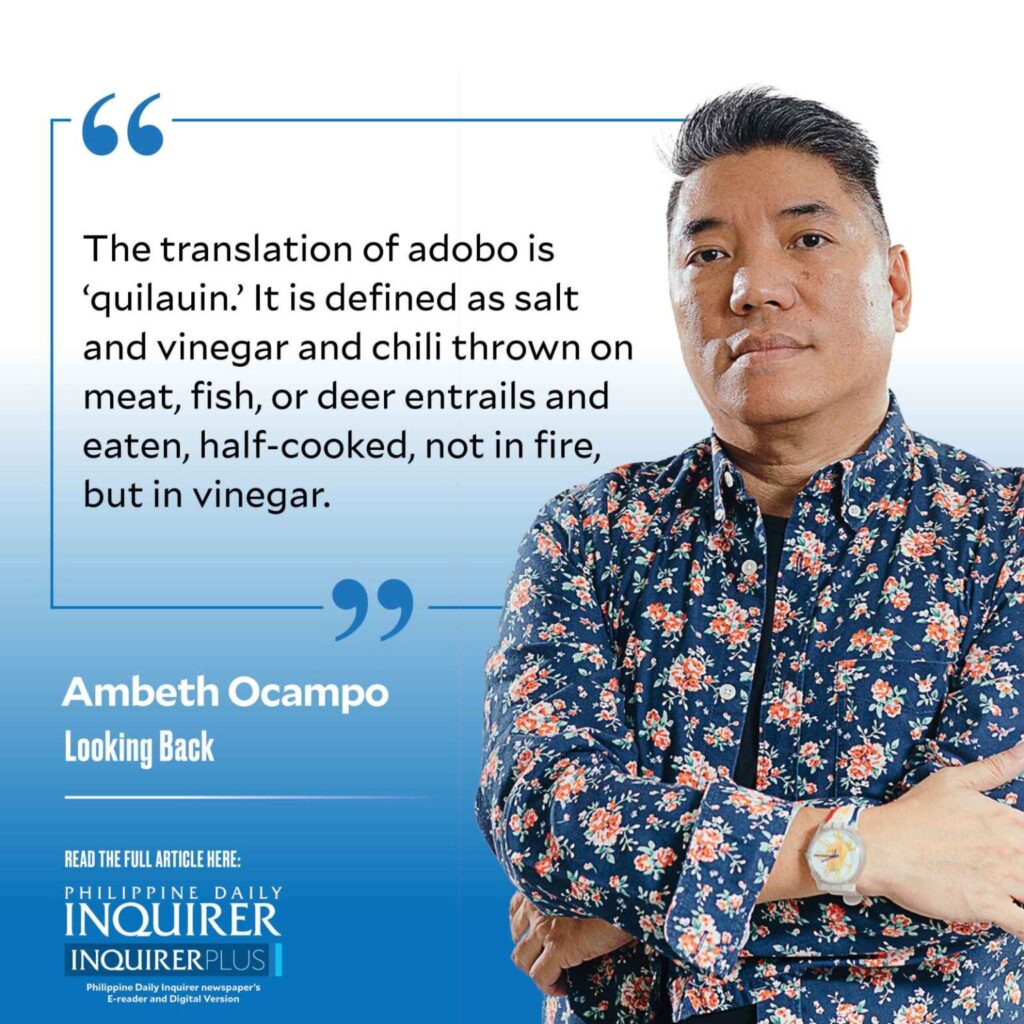
Contrary to popular belief, adobo is not a Spanish dish. Filipinos have had adobo long before Ferdinand Magellan sailed into our shores in 1521. Adobo is the Philippines’.
Adobo is not the name of a dish, but is a process of marinating or pickling in vinegar. During the contact period, Spaniards sampled our cuisine and said, “Hey this is adobado” or marinated in vinegar. They forgot to ask their informant what the dish was called, so that is lost to history now.
Browsing through the food terms in “Vocabulario de la lengua tagala” by fray Domingo de los Santos (1794), the translation of adobo is “quilauin.” It is defined as salt and vinegar and chili thrown on meat, fish, or deer entrails and eaten, half-cooked, not in fire, but in vinegar.
He noted that this type of adobo on greens could serve as a salad. The phrase “nagquiquilauin doon sa amin” is recorded. It is significant that there is no garlic or “toyo” (soy sauce) in the description. So what does that make of the Department of Trade and Industry’s initiative to define and “standardize” Philippine adobo as part of the country’s cultural or “soft” diplomacy?
Compared to Doreen Fernandez and Felice Sta. Maria, I am a mere dabbler in Philippine food history. My undergrad thesis on food in Pampango culture was done primarily to connect with my paternal roots, learn the language, and develop a palate that can tell good food from bad. Frankly, I prefer eating and tasting than archival research.
As mentioned in my previous column, there are many entries in the De los Santos “Vocabulario” that pertains to rice. Not just rice varieties, but descriptions of rice in the different stages of development from “palay” (raw unhusked) to “bigas” (husked rice) to “sinaing” (cooked rice) or “binulaclac” (popped rice). “Macabohay olila” (literally “to raise an orphan”) is rice that is not totally hard and can already be eaten. “Bolobor” is rice before transplanting, and when planted “nagbabarar nagoogat” that references taking root. “May mota” describes rice when it has a film, like mote in the eyes. “Mongana” when the rice bears fruit. “Malagatas” when it is ripe but still young and soft. It is ready to eat when hard. “Dayapa” describes rice stalks swaying in the wind “nadayapa nanghangin ang aming palay.” What we call “malagkit” today was “lagquitan” in the 18th century that was used for “cacanin” and “calamay.” Other terms are: “buticas,” “basag,” “caraeo,” “loba,” “binlir,” etc.
Fernandez stated that, in her research, the most number of food references in early Tagalog vocabularios pertain to rice and fish that reflect the Philippine diet. When I looked under fish, there were two types, “pescado” (fish) and “pescadillo” (small fish). “Dilis” was described as the size of a thin finger and that much was caught near Manila. “Dolong” was a small fish caught in rivers and lakes. “Quitiquiti” that today we use to refer to “wrigglers” or mosquito larvae was a small fish bigger than dolong. “Maquitituiti dito” (there are many small fish here).
“Pescado” translated as “ysda” and a fish vendor was “naglalaco ng ysda.” The types mentioned are: “talangtalang,” a salt fish; “talaquitoc,” a good fish whose fresh water type is better than its salt water cousin; “dalag,” very ordinary such that fishermen would apologize: “Dalag lamang ang huli naming.” “Malasugui” is a very precious fish caught in Mauban; “pantat,” from mountain rivers, very suave; “biya,” very ordinary, white, caught in rivers and Laguna de Bay; “tagan” or “espada” is very big and battles with crocodiles. “Salap” are small fish caught in nets with shrimp.
“Palacaya” means to fish, as in “Pinalacayaco yaring isda. Vuala acong palalacayahang banca.” A fisherman is “malalacaya,” so “nag mamalalacaya ca.” There are words for fishing net (“lambat”), fish basket (“salacab”), descriptions of hooks, and the difference between fishing in salt or fresh water or even in the high seas, and so much more beyond my skill set because I only buy fish from a supermarket and do not know how these were caught.
Hours and hours of fun.
—————-
Comments are welcome at aocampo@ateneo.edu
